Beech wood offers a pale, consistent grain ideal for modern interior trim, while cherry wood provides rich reddish tones and natural darkening over time, enhancing traditional designs. Beech is durable and cost-effective, whereas cherry is valued for its warm aesthetic and fine texture.
Table of Comparison
| Feature | Beech | Cherry |
|---|---|---|
| Hardness (Janka) | 1,300 lbf | 995 lbf |
| Grain | Fine, straight | Fine, smooth |
| Color | Light cream to pinkish brown | Reddish brown, darkens with age |
| Workability | Good, machines well | Excellent, sands smooth |
| Durability | Moderate | High |
| Cost | Lower | Higher |
| Uses | Interior trim, furniture, flooring | Interior trim, cabinetry, fine furniture |
Introduction to Beech and Cherry Wood
Beech wood is a durable hardwood known for its fine, tight grain and pale cream color with a slight pink hue, making it ideal for interior trim that demands strength and subtle elegance. Cherry wood, prized for its rich reddish-brown color and smooth grain, develops a deep patina over time, enhancing its luxurious appeal in interior millwork and trim applications. Both woods offer excellent machinability and finishing qualities, but cherry's warm tones contrast with beech's lighter, more neutral appearance, influencing design choices in interior decor.
Visual Differences: Color and Grain
Beech wood for interior trim features a light, creamy color with a fine, uniform grain that offers a smooth and consistent appearance. Cherry wood showcases a rich reddish-brown hue that deepens with age, paired with a distinctive, subtle grain pattern that often includes fine swirls and cathedrals. The visual contrast between Beech's pale, even texture and Cherry's warm, vibrant tones makes Cherry a popular choice for adding natural warmth and elegance to interior spaces.
Durability and Hardness Comparison
Beech wood exhibits higher hardness with a Janka rating of approximately 1,300, making it more resistant to dents and wear compared to Cherry, which has a Janka rating around 950. The dense and fine grain structure of Beech provides enhanced durability ideal for high-traffic interior trim areas, while Cherry's softer texture lends to easier machining but greater susceptibility to scratches. Over time, Beech maintains structural integrity better, whereas Cherry develops a rich patina that, despite its lower hardness, contributes to aesthetic appeal in interior woodworking applications.
Workability and Ease of Installation
Beech wood offers excellent workability due to its fine, tight grain and uniform texture, making it easy to saw, sand, and shape for interior trim projects. Cherry wood is also user-friendly but may require more care during installation because of its softer nature, which can dent or scratch more easily compared to beech. Both woods provide smooth finishes, but beech generally allows for quicker installation and fewer adjustments due to its stability and resistance to warping.
Cost and Availability
Beech wood typically costs less than cherry, making it a budget-friendly option for interior trim projects. Its widespread availability in North America and Europe ensures consistent supply and quicker delivery times. Cherry, valued for its rich color and fine grain, commands higher prices and may require longer lead times due to more limited availability.
Finishing and Staining Properties
Beech features a tight, uniform grain that accepts stains evenly, producing a smooth, consistent finish ideal for interior trim requiring a polished appearance. Cherry wood's fine, straight grain darkens naturally over time, enhancing stain absorption and resulting in a rich, warm patina that adds character to trimwork. Both woods respond well to finishes, but Beech's pale color allows for greater versatility in stain choices, while Cherry's natural hue often requires lighter or clear finishes to showcase its evolving tones.
Maintenance and Longevity
Beech interior trim offers excellent durability with a hard, dense grain that resists dents and wear, requiring minimal maintenance beyond regular dusting and occasional refinishing to maintain its appearance. Cherry, known for its rich color that deepens over time, demands slightly more care to prevent scratches and fading, including periodic polishing and protection from direct sunlight. Both woods provide long-lasting trim options, but Beech tends to outperform Cherry in high-traffic areas due to its superior hardness and resistance to daily wear.
Environmental Impact and Sustainability
Beech wood, sourced predominantly from European forests, is often lauded for its sustainability due to its fast growth rate and high demand which encourages responsible forestry practices certified by PEFC or FSC. Cherry wood, native to North America, grows more slowly and is less abundant, leading to higher environmental concerns regarding overharvesting and habitat disruption, despite its durability and aesthetic appeal. Choosing beech for interior trim supports lower carbon footprints and promotes sustainable forest management, while cherry may require stricter sourcing scrutiny to ensure eco-friendly practices.
Best Applications for Interior Trim
Beech wood's fine, uniform grain and excellent workability make it ideal for interior trim requiring smooth, consistent finishes like baseboards, chair rails, and window casings. Cherry wood offers rich, warm hues with natural aging benefits, making it suited for decorative trim and molding in upscale or traditional interiors where aesthetics are paramount. Both woods provide durability, but Beech excels in high-traffic areas due to its hardness, while Cherry is preferred for its elegant appearance in formal settings.
Choosing Between Beech and Cherry: Final Recommendations
Beech offers a tight grain and light color, making it ideal for modern, minimalist interior trim with durability and smooth finishes. Cherry wood features warm reddish tones and deepens in color over time, providing a luxurious and classic look suited for traditional settings. Choose Beech for cost-effective, uniform aesthetics and Cherry for rich, elegant appeal with natural aging characteristics.

Infographic: Beech vs Cherry for Interior Trim
 azmater.com
azmater.com